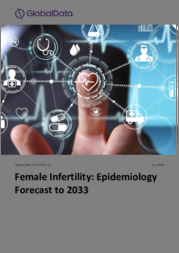
불임은 피임 없이 12개월 이상 정기적인 성관계에도 불구하고 임상적 임신에 이르지 못하는 것으로 정의되는 생식기관 질환입니다. 불임은 수백만 명의 사람들에게 영향을 미치며 가족과 지역사회에 영향을 미칩니다. 전 세계 가임기 인구의 약 6명 중 1명이 일생 동안 불임을 경험하게 될 것으로 추정된다(세계보건기구, 2024년). 불임에는 두 가지 유형이 있습니다. 1차성 불임은 동거 또는 무방비 상태의 성관계가 있고, 최소 12개월 이상 임신을 원했지만 임신이 되지 않는 경우를 말합니다. 이차성 불임은 여성이 과거에 임신을 한 적이 있지만 이후 동거, 피임 없이 성관계, 최소 12개월 이상 임신을 원했지만 임신을 하지 못한 경우를 말합니다. 여성 생식계에서는 난소, 자궁, 난관, 내분비계 등 다양한 이상에 의해 불임이 유발될 수 있습니다.
생식 연령대의 여성 중 상당수가 불임을 경험하고 있습니다. 불임은 일반적으로 1년 동안 임신을 시도해도 임신이 잘 되지 않는 것을 말하며, 가임력 장애는 임신을 하거나 임신을 지속하는 데 문제가 있는 것을 말합니다. 불임과 가임력 장애의 주요 원인 요인은 난관 기능 장애, 월경 장애, 성 장애, 노화, 그리고 일부 환자의 경우 난소 기능 장애입니다. 최근 몇 년동안 불임이 점점 더 흔해졌지만 현대 의학의 첨단 보조생식기술의 사용은 불임 문제를 해결할 수 있는 가능성을 크게 높였습니다.
여성의 불임은 사회인구학적, 행동학적, 신체적, 정신적 건강 상태 등 여러 가지 요인이 관여할 수 있는 것으로 알려져 있습니다. 불임에 영향을 미치는 위험 요인 중 일부는 바꿀 수 없는 것도 있지만, 생활습관 선택과 같이 바꿀 수 있는 것도 있습니다. 흡연, 비만, 당뇨병 등 많은 행동 요인이나 건강 상태는 예방이 가능한 경우가 많습니다. 특정 인종과 민족, 사회경제적 지위, 치료 접근성, 불임 치료 서비스/치료 이용도 여성 불임의 높은 유병률과 연관된 요인으로 지적됐습니다.
주요 7개국에서 여성 불임으로 진단된 우발적 사례는 2023년 42만 793건에서 2033년 408,771건으로 감소해 연간 성장률(AGR)이 0.29% 감소할 것으로 예상되며, 2033년 미국이 139,027건으로 주요 7개국 중 가장 많을 것으로 예상된다, 스페인이 2만 6,859건으로 가장 적습니다.
이 보고서는 주요 7개국의 시장의 여성 불임 위험 요인, 동반 질환, 세계 및 과거 역학 동향을 개괄하고, 불임 진단 사례와 진단된 유병률에 대한 10년간의 역학 예측 등을 정리했습니다.
Infertility is a disease of the reproductive system defined by the failure to achieve a clinical pregnancy after 12 or more months of regular unprotected sexual intercourse (Zegers-Hochschild et al., 2009; Mascarenhas et al., 2012; Mayo Clinic, 2021; World Health Organization, 2024). Infertility affects millions of people and has an impact on their families and communities. Estimates suggest that approximately one in every six people of reproductive age worldwide experience infertility in their lifetime (World Health Organization, 2024). There are two types of infertility. Primary infertility refers to when a woman has never conceived despite cohabitation, unprotected sexual intercourse, and the wish to become pregnant for at least 12 months. Secondary infertility refers to when a woman has previously conceived but was subsequently unable to conceive despite cohabitation, unprotected sexual intercourse, and the wish to become pregnant for at least 12 months (Zegers-Hochschild et al., 2009; Mascarenhas et al., 2012). In the female reproductive system, infertility may be caused by a range of abnormalities of the ovaries, uterus, fallopian tubes, and the endocrine system, among others (Mayo Clinic, 2021; World Health Organization, 2024).
A considerable proportion of women of reproductive age experience infertility. Infertility generally refers to a difficulty in becoming pregnant after trying to conceive for one year, whereas impaired fecundity includes problems either in becoming pregnant or carrying a pregnancy to term (Chandra, Copen and Stephen, 2014). The major causative factors of infertility and impaired fecundity are fallopian tube dysfunction, disorders of menstruation, sexual disorders, increasing age, and in a very small percentage of patients, ovarian failure. Although infertility is more prevalent in recent times, the use of advanced assisted reproductive technologies in modern medicine greatly increases the chances of solving infertility problems (Roupa et al., 2009).
Multiple factors have been identified as possible contributors to fertility problems in women, including socio-demographic, behavioral, physical, and mental health conditions. Some risk factors affecting fertility cannot be changed, while others such as lifestyle choices may be altered. Many of the behavioral factors and health conditions may be preventable, such as smoking, obesity, and diabetes. Certain races or ethnicities, socioeconomic status, access to care, and use of infertility services/treatments were also noted as factors tied to a higher prevalence of female infertility (Crawford et al., 2017).
In the 7MM, the diagnosed incident cases of female infertility are expected to decrease from 420,793 cases in 2023 to 408,771 cases in 2033, at a negative annual growth rate (AGR) of 0.29%. In 2033, the US will have the highest number of diagnosed incident cases of female infertility in the 7MM, with 139,027 diagnosed incident cases, whereas Spain will have the fewest diagnosed incident cases with 26,859 cases.
In the 7MM, the total prevalent cases of female infertility are expected to decrease from 16,732,165 cases in 2023 to 16,053,363 cases in 2033, at a negative AGR of 0.41%. In 2033, the US will have the highest number of total prevalent cases of female infertility in the 7MM, with 5,492,669 cases, whereas Spain will have the fewest cases with 1,009,964 total prevalent cases. GlobalData epidemiologists attribute the changes in the diagnosed incident cases and total prevalent cases to the underlying demographic changes in the respective markets.
The Female Infertility epidemiology series will allow you to -